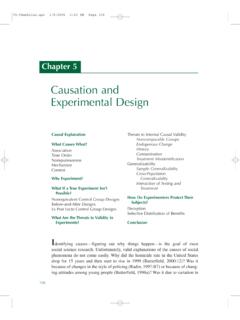Transcription of Causes of Crime
1 The Root Causes of Crime 1 THE ROOT Causes OF CRIMECS&CPC Statement on the Root Causes of Crime approved in 1996 The Root Causes of Crime 2 Overview Individuals need to be responsible for their own actions. An understanding of root Causes cannot and should not be seen as a way to absolve us from personal accountability. However, while individuals have an obligation to act responsibly and with respect for their fellow citizens, communities have a responsibility to address those conditions, which hinder healthy development and can become the breeding ground for rime. The root Causes of Crime are well documented and researched. Crime is primarily the outcome of multiple adverse social, economic, cultural and family conditions.
2 To prevent Crime it is important to have an understanding of its roots. These are complex and interrelated, but can be summarized in three main categories: Economic Factors/Poverty Social Environment Family Structures Economic Factors/Poverty In addition to lack of financial resources, poverty manifests itself in a lack of educational opportunities, lack of meaningful employment options, poor housing, lack of hope and the prejudice against persons living in poverty. Social Environment Our social structure mirrors to citizens and communities what we value and how we set priorities. Social root Causes of Crime are: inequality, not sharing power, lack of support to families and neighborhoods, real or perceived inaccessibility to services, lack of leadership in communities, low value placed on children and individual well-being, the overexposure to television as a means of recreation.
3 Family Structures The CSCPC believes that families are uniquely placed in contributing to raising healthy responsible members of society. But the task of putting children first goes well beyond the family to include communities and society. Dysfunctional family conditions contribute to future delinquency. The Root Causes of Crime 3 These conditions include: Parental inadequacy Parental conflict Parental criminality Lack of communication (both in quality and quantity) Lack of respect and responsibility Abuse and neglect of children Family violence Crime prevention must focus on improvements in all three areas. From Reaction to Prevention Crime can be closely linked to the conditions for children in our community.
4 There is a strong link between reducing risk and building resilience in children and decreasing Crime . Problems arise when the larger social, political and economic systems within which children live jeopardize the family's resources and create stress on the family unit. As a result, the provision of appropriate care and required resources to all children will have great significance for their long term physical, intellectual, and emotional well-being and their development into independent, healthy adults. The offender of tomorrow is often the vulnerable child of today. Vulnerable children are those at risk for significant and enduring social, emotional, or behavioural problems.
5 These children are more likely to be dependent on public resources over the course of their development, particularly through the child welfare, social assistance, corrections, or mental health service systems. All children are potentially vulnerable and may develop emotional or behavioural problems when their own physical or emotional resources are unable to meet the challenges of their social and physical environment. There are three levels of prevention: 1. Primary PreventionPrimary prevention efforts try to ensure the health of the community as a whole by attempting to stop adverse conditions from developing in the first place. Programs which address parenting, family support, adequate housing, etc.
6 Could all be considered primary prevention if they areuniversally accessible and offered before any difficulties are identified. Primary prevention can be the most cost-effective method of dealing with a problem because it can reduce costs in many The Root Causes of Crime 4different areas over the long term. Universal programs are only ever as effective as their ability to include and support populations at risk. 2. Secondary PreventionSecondary prevention attempts to stop a Crime from occurring after certain "warning signs" have appeared. An example might be programs, which focus on a specific problem or problem group. Anti-social or delinquent behaviour ( , disrespect for school staff; spray-painting slogans on buildings) can often be stopped through early intervention in problem situations before they become more serious and lead to a life of Crime or victimization.
7 3. Tertiary PreventionLaw enforcement efforts generally fall into the category of tertiary prevention. Sentencing a person to prison ensures that they will not commit a Crime while serving their sentence. This is Crime prevention after the fact because the person is known to the community and has already broken the law. While these measures ensure (for a time) that an offender cannot commit another offense they cannot reverse the effects of the original Crime . Fundamental to prevention is a commitment to the essentials of adequate care for all children. The CS&CPC is a proud partner of the Alliance for Children and Youth of Waterloo Region. The Alliance emphasizes strengths based approaches.
8 Preventative efforts strive to achieve the following goals: Reduce the incidence of serious, long-term emotional and behavioral problems in all children. Promote the optimal social, emotional, behavioral and cognitive development in children at highest risk. Strengthen the ability of communities to respond effectively to children and their families in social and economic need. Successful prevention programs share many of the following characteristics: Enhance children's mental health and promote a healthier environment for children. Are freely accessible to all children Do not single out or stigmatize individuals, families or communities Focus on education, building competence and skills Actively include families and communities in development and implementation The Root Causes of Crime 5 Maximize the likelihood of positive outcomes and produce cost-savings when compared to treatment Risk Factors When several risk factors are combined, there is a higher probability that Crime occurs.
9 "Root Cause" is not the most accurate term when talking about risk factors. In fact a cause-effect mind-set makes it too easy to assume that the existence of a risk factor inevitably leads to criminality. For example, the research literature overwhelmingly points to poverty as a factor in criminal behaviour. However, many poor people do not engage in Crime . A great deal of research and study has taken place in the field of criminology over the past 50 years. The data is supported by life-cycle studies in other disciplines including health, education and social science. Research from studies in Europe, Canada and the examined personal characteristics of convicted offenders, relationships with family and peers, self reporting data, neighborhood characteristics and other data to come to four major conclusions: Occasional and Persistent Delinquents We need to distinguish between occasional and persistent offenders.
10 For example, 81% of adolescents commit a criminal offence at some time during their adolescence ( mischief, experimentation with drugs, shoplifting, etc.); 9% of adolescent offenders commit serious offenses. In economically disadvantaged areas, 7% of men are responsible for over 50% of all offenses. Persistent offenders engage in criminal behavior earlier and continue longer. High Crime Areas Crime rates differ markedly within cities as well as different areas across Canada. For example, northern communities in Canada have substantially higher violent and property crimes than the national average. Police forces everywhere can point to neighbourhoods and urban areas which experience higher Crime rates.


